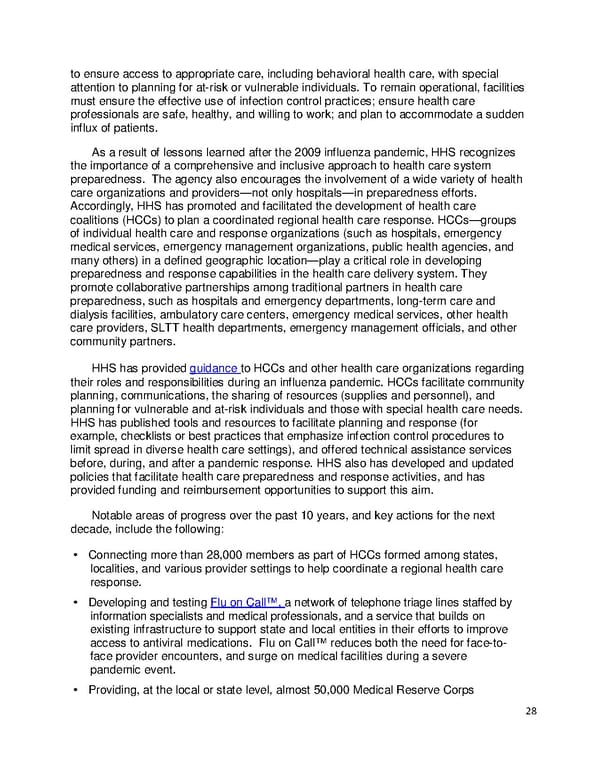to ensure access to appropriate care, including behavioral health care, with special attention to planning for at-risk or vulnerable individuals. To remain operational, facilities must ensure the effective use of infection control practices; ensure health care professionals are safe, healthy, and willing to work; and plan to accommodate a sudden influx of patients. As a result of lessons learned after the 2009 influenza pandemic, HHS recognizes the importance of a comprehensive and inclusive approach to health care system preparedness. The agency also encourages the involvement of a wide variety of health care organizations and providers—not only hospitals—in preparedness efforts. Accordingly, HHS has promoted and facilitated the development of health care coalitions (HCCs) to plan a coordinated regional health care response. HCCs—groups of individual health care and response organizations (such as hospitals, emergency medical services, emergency management organizations, public health agencies, and many others) in a defined geographic location—play a critical role in developing preparedness and response capabilities in the health care delivery system. They promote collaborative partnerships among traditional partners in health care preparedness, such as hospitals and emergency departments, long-term care and dialysis facilities, ambulatory care centers, emergency medical services, other health care providers, SLTT health departments, emergency management officials, and other community partners. to HCCs and other health care organizations regarding HHS has provided guidance their roles and responsibilities during an influenza pandemic. HCCs facilitate community planning, communications, the sharing of resources (supplies and personnel), and planning for vulnerable and at-risk individuals and those with special health care needs. HHS has published tools and resources to facilitate planning and response (for example, checklists or best practices that emphasize infection control procedures to limit spread in diverse health care settings), and offered technical assistance services before, during, and after a pandemic response. HHS also has developed and updated health care preparedness and response activities, and has policies that facilitate provided funding and reimbursement opportunities to support this aim. Notable areas of progress over the past 10 years, and key actions for the next decade, include the following: • Connecting more than 28,000 members as part of HCCs formed among states, localities, and various provider settings to help coordinate a regional health care response. • Developing and testing Flu on Call™, a network of telephone triage lines staffed by information specialists and medical professionals, and a service that builds on existing infrastructure to support state and local entities in their efforts to improve access to antiviral medications. Flu on Call™ reduces both the need for face-to- face provider encounters, and surge on medical facilities during a severe pandemic event. • Providing, at the local or state level, almost 50,000 Medical Reserve Corps 28
 Pandemic Influenza Plan Page 27 Page 29
Pandemic Influenza Plan Page 27 Page 29